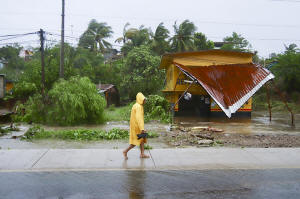Hurricane John falls apart after causing deadly mudslides on Mexico's
southern Pacific coast
 Send a link to a friend
Send a link to a friend
 [September 25, 2024]
By LUIS ALBERTO CRUZ [September 25, 2024]
By LUIS ALBERTO CRUZ
MARQUELIA, Mexico (AP) — Hurricane John fell apart as quickly as it
formed but left destruction along Mexico's southern Pacific coast
Tuesday, including deadly mudslides and flooding that may linger for
days.
John was a Category 3 hurricane when it made landfall late Monday night
near the town of Punta Maldonado, with winds of 120 mph (190 kph). It
weakened to a tropical depression Tuesday with maximum sustained winds
of 35 mph (55 kph), the U.S. National Hurricane Center said.
Mexican authorities discontinued all tropical storm warnings as the
storm system dawdled along the coastal mountains and continued to
weaken. It was 70 miles (115 kilometers) northwest of Acapulco and
moving northwest at 3 mph (6 kph) at midday.
John blew tin roofs off houses, triggered mudslides and toppled scores
of trees.
Two people died when the storm sent a mudslide crashing into their house
on the remote mountain of Tlacoachistlahuaca (TLAH-ko-chis-tla-waka),
further from the coast. Guerrero Gov. Evelyn Salgado said. A third death
occurred in Malinaltepec when a landslide hit the home of a 70-year-old
woman, according to Guerrero state officials.

No deaths or injuries had been reported so far in the town of Marquelia,
near where the hurricane made landfall, which Mayor Lincer Casiano
Clemente attributed to his ability to warn residents of the storm’s
approach. But power was knocked out along large parts of the coast, and
highways were blocked by fallen trees. The government said some 60,000
people remained without power.
“We’ve never seen such strong gusts,” the mayor said. "There are a lot
of houses, mainly the ones with sheet roofing, where the force of the
air blew off the roofing.”
By Tuesday morning, people were out looking for food, he said.

[to top of second column]
|

A person walks in the rain after the passing of Hurricane John in
Marquelia, Mexico, Tuesday, Sept. 24, 2024. (AP Photo/Luis Alberto
Cruz)

U.S. forecasters said the main concern was flash flooding in the
coming days. Through Thursday, between 25 and 50 centimeters (10 and
20 inches) of rain could fall along the Oaxaca coast to southeast
Guerrero, with isolated higher amounts in places.
Monday's unexpected surge in strength caught scientists, authorities
and residents of the area by surprise, something AccuWeather Senior
Meteorologist Matt Benz attributed to warmer oceans, which add fuel
to hurricanes.
As a result, surprise surges in hurricanes' strength have become
increasingly common, Benz said.
“These are storms that we haven’t really experienced before,” he
said. “Rapid intensification has occurred more frequently in modern
times as opposed to back in the historical record. So that’s telling
us there’s something going on there.”
The region was walloped by another rapidly intensifying hurricane,
Otis, in 2023.
Otis devastated the resort city of Acapulco, where residents had
little warning of the strength of what was about to hit them. One of
the most rapidly intensifying hurricanes ever seen, scientists at
the time said it was a product of changing climate conditions.
Otis blew out power in the city for days and left bodies scattered
on the coast. Much of the city was left in a state of lawlessness
and thousands scavenged stores for food and water.
Oaxaca and other parts of the Pacific coast seemed to have avoided
the devastation witnessed last year in Acapulco.
___
AP writer María Verza in Mexico City contributed to this report.
All contents © copyright 2024 Associated Press. All rights reserved |